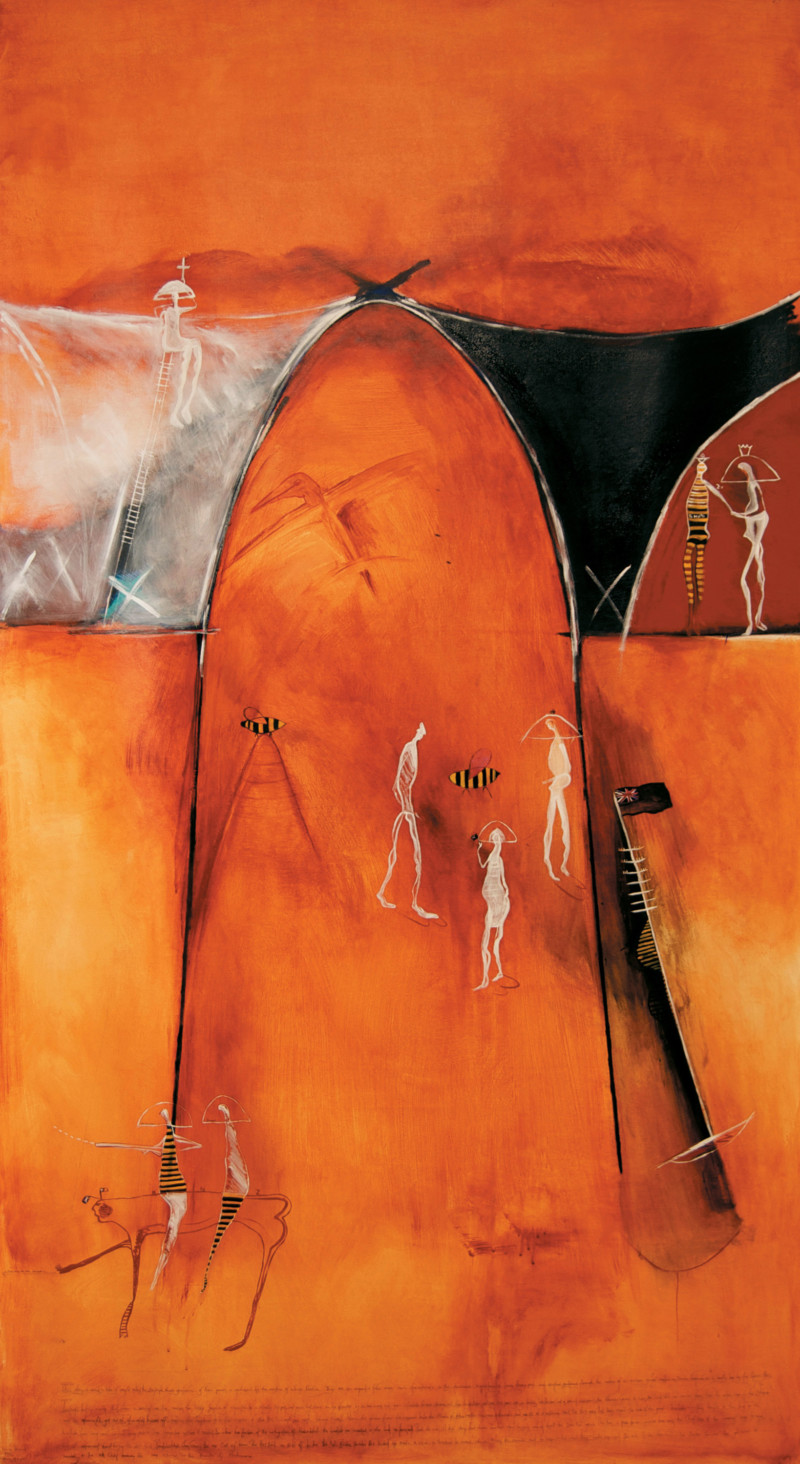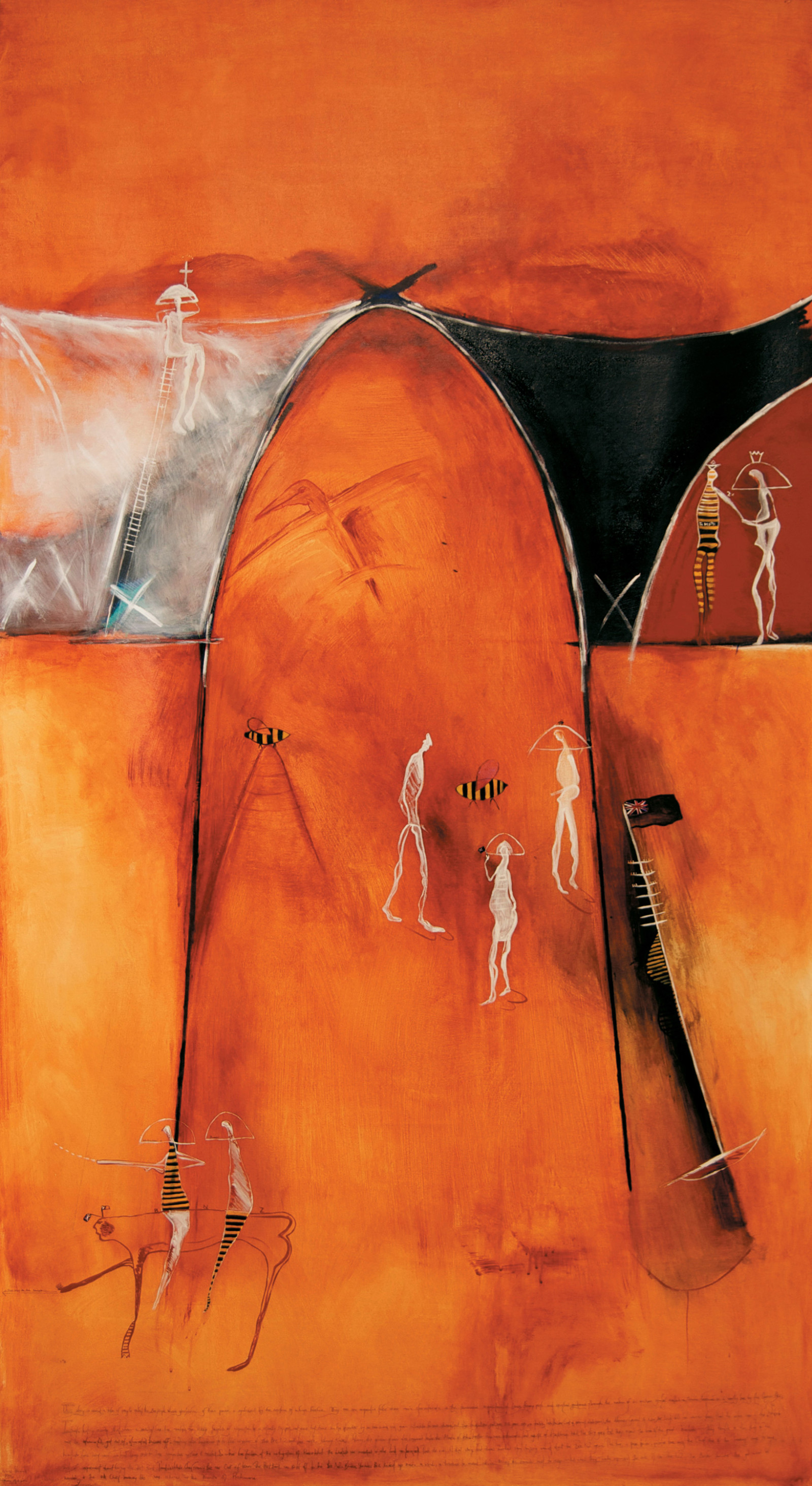PRINCE, Diane;
Odyssey of a Sale
1996
Acrylic on unstretched canvas
2475 x 1280mm

Diane Prince’s Odyssey of a Sale is an exploration of colonial structures and processes. It responds in particular to the activities of Frederick Whitaker and Thomas Russell in the mid-19th century, and those of Roger Douglas and Michael Fay in the late 20th century. A lengthy prose-poem is inscribed on the work. A transcription (with minor corrections) follows.
‘This story is about a tribe of people called the Bee People whose glorification of their power is symbolised by the erection of a huge beehive. They are an acquisitive tribe, whose main characteristic is the tenacious acquisition of land, honey pots and spiritual guidance through the medium of an archaic symbol called a Crown: bestowed on a worthy bee by the Queen Bee.’
‘In fact, history records that when a ‘worthy’ bee has reached the dizzy heights of acquisition he is ritually tapped, not once but twice on his shoulder by a bee sword and given ritualistic favours throughout the land. Now just over 100 years ago, a Freddy Whittacker (not of peanut slab fame), the Attorney General of New Bee Land, told his warrior bees that the native bees of the Waikato must be exterminated, got rid of, eliminated, buzzed off.’
‘Freddy also happened to be the co-owner of the Bee NZ with his mate, Johnny Russell. Johnny, the aforementioned, also happened to be the Minita of War [Minister of Defence]. Together they were enthusiastic land agents of Auckland. Well, the story goes that they espied the lands of the great Waikato—trouble is, the King of the Waikato bees didn’t want his land being sold to those foreign bees up there & resisted. So, in true bee fashion, at the instigation of Russ & Whitt, the Waikato was invaded & the land confiscated.’
‘That’s the end of that story, but there’s another story buzzing around about the Bee NZ again. This time, a prize banker yachtee bee [Michael Fay] and the Chief bee of the Treasury [Minister of Finance Roger Douglas] came to some sort of agreement about buying the Post Bank. Trouble is, while Chief Money Bee was out of town, the Post Bank was sold off to the [ANZ].’
‘Banker Yachtee Bee kicked up such a stink, he threatened to reveal all. So, Money Bee Minister had to resign—but when they finally organised the sale of the Bee NZ, the Banker Yachtee Bee got what he wanted, major ownership, & the old Chief Money Bee was returned as the Minita of Pirihimana [Minister of Police].’
The following two texts were written for Te Huringa/Turning Points and reflect the curatorial approach taken for that exhibition.
Peter Shaw
Diane Prince is a leading multimedia artist, weaver, and award-winning set designer. She is also an important social and political commentator, and a veteran of Takaparawhau Bastion Point, as well as many hīkoi and Māori sovereignty protests. She has worked extensively with indigenous artists in North America and the Pacific and been involved in cross-cultural exchanges.
Odyssey of a Sale explores the theme of land as a contested site, taking the form of an allegory charting events that are the result of actions taken by the Crown and its agents. In it, either visually or in the prose poem along the work’s lower section, there are references to Treaty settlements, the America’s Cup, big business’s relationships with the Crown, the ‘fiscal envelope’, and the goings-on of MPs in the Beehive itself.
Jo Diamond
A deeply allegorical comment on colonialism in Aotearoa, this work uses bee-like forms to refer to this country’s nexus of political power, the ‘Beehive’ Parliament building in Te Whanganui-a-Tara, and its powerful inhabitants. Prince, a respected advocate of Māori rights and critic of that Pākehā hegemony that has brought numerous inequalities and injustices to Māori people, never illustrates Aotearoa as a land of blissful equality. In this painting, the overwhelming presence of politico ‘bees’ who enjoy disproportionate wealth and power is highlighted. It also reflects the fact of Māori people’s continued struggle against cultural alienation and the inequity of a system that has harmed them in various ways.
Prince’s work reflects the fact that many Māori people consider parliamentary busy-bees as complicit in both continued dubious dealings with off-shore enterprises and internal policies that directly and negatively affect Māori culture. Although this painting precedes the foreshore and seabed controversy, its relevance to that issue and many others that have taken place ever since the advent of British colonisation remains startlingly real.
Inscriptions
Diane Prince / 1996 / 'Odyssey of a Sale' [l.l.]Exhibition History
Te Huringa/Turning Points: Pākehā Colonisation and Māori Empowerment, Sarjeant Gallery Te Whare o Rehua, Whanganui, 8 April to 16 July 2006 (toured)
Provenance
1999–
Fletcher Trust Collection, purchased February 1999

